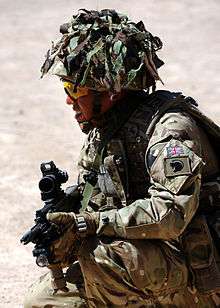4th Infantry Brigade and Headquarters North East
| Heavy Armoured Brigade (Egypt) 4th Armoured Brigade 4th Armoured Brigade Group 4th Mechanized Brigade 4th Infantry Brigade and Headquarters North East | |
|---|---|
|
Current insignia of the 4th Mechanized Brigade. | |
| Active |
1939–1945 1976–Present |
| Country |
|
| Branch |
|
| Type | Mechanized |
| Size | Brigade |
| Part of |
7th Armoured Division 1st (United Kingdom) Division |
| Garrison/HQ | Catterick, North Yorkshire |
| Nickname(s) | The Black Rats |
| Engagements |
Gulf War Bosnian War Kosovo Campaign Iraq War Afghanistan |
| Commanders | |
| Current commander | Brigadier Charlie Herbert |
| Notable commanders | Michael Carver |
The 4th Infantry Brigade and Headquarters North East (The Black Rats), previously known as 4th Mechanized Brigade (The Black Rats) is a brigade formation of the British Army, currently based in Catterick, North Yorkshire as part of 1st (United Kingdom) Division.[1] The brigade, now known as the 'Black Rats', was formed in 1939 and fought in the Second World War in the Western Desert Campaign in North Africa. The Black Rats were subsequently involved in the invasion of Sicily and fighting in Italy before taking part in the Battle of Normandy and the advance through Belgium, Holland and into Germany.[2]
More recently, the Brigade took part in the First Gulf War and completed a number of tours to the Balkans during the 1990s. The Black Rats have since deployed twice to Iraq and once before to Afghanistan for Operation Herrick 12 in 2010. The Brigade returned to Helmand Province, Afghanistan in October 2012 for Operation Herrick 17 to take over as the lead formation of British troops. The roulement tour saw the brigade working in support of the Afghan Army's 3/215 Brigade and elements of the Afghan National Police.
History
World War II
In September 1939, at the start of the Second World War this brigade changed its title from Heavy Armoured Brigade (Egypt) to 4th Armoured Brigade.[3]
On 27 July 1941 it handed over its units to the 1st Army Tank Brigade and received new units from Egypt. It was reformed again when the HQ arrived in Sicily and it took control of new units there. The 4th Armoured Brigade saw service in the North African Campaign, Allied invasion of Sicily, Italian Campaign and in North-western Europe. Although it served under many different formations it was most famous as part of the 7th Armoured Division, the Desert Rats.[3]

The 4th Armoured Brigade left the 7th Armoured Division in North Africa in 1943 for the Allied Invasion Force for Normandy. In June 1944 Brigade troops landed in Normandy and served with distinction in the Battle of Normandy during the Battle for Caen. From Normandy until the end of the war the 4th Armoured Brigade was composed as follows:
- Royal Scots Greys (left 29 April 1945)
- 44th Royal Tank Regiment
- 3rd County of London Yeomanry (Sharpshooters) (became 3rd/4th County of London Yeomanry (Sharpshooters) 29 July 1944)
- 2nd Battalion, King's Royal Rifle Corps (left 14 May 1945)
- 1st East Riding Yeomanry (from 14 June 1945)
The 4th Armoured Brigade was the first to cross the Rhine into Germany.[4]
Order of battle World War II
Cold War Era
The Brigade spent many years in Germany as part of the British Army of the Rhine. The brigade was one of two "square" brigades assigned to 1st Armoured Division when it was formed in 1976.[5] After being briefly converted to "Task Force Charlie" in the late 1970s, the brigade was reinstated in 1981, assigned to 3rd Armoured Division[6] and was based at York Barracks in Münster.[7] The Brigade deployed to the First Gulf War on Operation Granby in 1990/91 and was involved in the liberation of Kuwait. It moved to Quebec Barracks at Osnabrück in 1993 to replace 12th Armoured Brigade as part of 1st (UK) Armoured Division.[8]
Post-Cold War

4th Armoured Brigade deployed to Bosnia in October 1995 as UNPROFOR HQ Sector South-West and subsequently as the leading UK element of the NATO Implementation Force (IFOR).[9] On its return to the United Kingdom in 2007 it was transferred from 1st (UK) Armoured Division to 3rd (UK) Mechanised Division.[9] The Black Rats have since deployed twice to Iraq and once before to Afghanistan for Operation Herrick 12 in 2010. The Brigade returned to Helmand Province, Afghanistan in October 2012 for Operation Herrick 17 to take over as the lead formation of British troops. The roulement tour saw the brigade working in support of the Afghan Army's 3/215 Brigade and elements of the Afghan National Police.[10]
2013 Formation
Brigade units in 2013 were:
- 204 Signal Squadron (Signals and Brigade HQ)
- The Queen's Royal Lancers (Formation Reconnaissance)
- The Royal Dragoon Guards (Armoured)
- 1st Battalion, Scots Guards (Armoured Infantry)
- 1st Battalion, The Duke of Lancaster's Regiment (King's Lancashire and Border) (Mechanized Infantry)
- 1st Battalion, The Mercian Regiment (Cheshire) (Light Role)
- 1st Battalion, Royal Regiment of Scotland, Royal Scots Borderers (Light Role Infantry)
- 4th Regiment Royal Artillery (Self Propelled Artillery)
- 21 Engineer Regiment Royal Engineers
- 1 Close Support Battalion, Royal Electrical and Mechanical Engineers
- 12 Logistic Support Regiment Royal Logistic Corps
- 3 Medical Regiment, Royal Army Medical Corps
Current formation
Under Army 2020, the brigade lost its armour and converted to an infantry brigade. The units to be under its control include:[11][12]
- 4th Infantry Brigade and Headquarters North East in Catterick
- Light Dragoons in Catterick with Jackal reconnaissance vehicles[13]
- Queen's Own Yeomanry in Newcastle with Land Rover RWMIK reconnaissance vehicles (Army Reserve - paired with Light Dragoons)[13]
- 2nd Battalion, Yorkshire Regiment in Catterick with Foxhound vehicles (rotates to British Forces Cyprus)[14]
- 4th Battalion, Yorkshire Regiment in York (Army Reserve - paired with 2nd Battalion, Yorkshire Regiment)
The Brigade was re-established in its current form on 1 December 2014.[15]
World War II Commanders
During World War II[16]
- 3 September 1939 - 1 November 1939 Lieutenant-Colonel HRB Watkins
- 1 November 1939 - 16 November 1939 Brigadier JAL Caunter
- 16 November 1939 - 5 December 1939 Lieutenant-Colonel HRB Watkins
- 5 December 1939 - 8 May 1941 Brigadier JAL Caunter
- 8 May 1941 - 26 June 1942 Brigadier AH Gatehouse
- 26 June 1942 - 7 July 1942 Brigadier AF Fisher
- 7 July 1942 - 4 October 1942 Brigadier WG Carr
- 4 October 1942 - 18 November 1942 Brigadier MG Roddick
- 18 November 1942 - 10 December 1942 Colonel RCG Joy
- 10 December 1942 - 24 January 1943 Brigadier CBC Harvey
- 24 January 1943 - 27 February 1943 Brigadier DS Newton-King
- 27 February 1943 - 30 December 1943 Brigadier JC Currie
- 30 December 1943 - 16 March 1944 Brigadier HJB Cracroft
- 16 March 1944 - 26 June 1944 Brigadier JC Currie
- 26 June 1944 - 27 June 1944 Colonel JL Young
- 27 June 1944 - 25 January 1945 Brigadier RMP Carver
- 25 January 1945 - 22 February 1945 Lieutenant-Colonel GC Hopkinson
- 22 February 1945 - 31 August 1945 Brigadier RMP Carver
Brigade Commanders
Recent commanders have included:[17]
- 1976–1978 Brigadier Desmond Langley
- 1981–1984 Brigadier Charles Guthrie
- 1994–1996 Brigadier Richard Dannatt
- 1996–1998 Brigadier David Richards
- 1998–2000 Brigadier Bill Rollo
- 2005–2007 Brigadier Chris Deverell
- 2007–2009 Brigadier Julian Free[18]
- 2009–2011 Brigadier Richard Felton[19]
- 2011–2013 Brigadier Bob Bruce[20]
- 2013–2015 Brigadier Charlie Herbert [21]
- 2015–present Brigadier Gerald Strickland
Notable former soldiers
Former BBC Motor sports commentator Murray Walker served with 4th Armoured Brigade during the Second World War as a member of The Royal Scots Greys. After the war he started a motorcycle club, organising trials and scrambles for the soldiers within the Brigade.[22]
See also
References
- ↑ 4th Mechanized Brigade (Official British Army website)
- ↑ Brigadier RMP Carter (1945). The History of the 4th Armoured Brigade. ISBN 978-1470119645.
- 1 2 Brief History Of The British 4th Armoured Brigade
- ↑ Desert Rats Association website (accessed 28 Aug 12)
- ↑ Watson, Graham (2005). "The British Army in Germany: An Organisational History 1947-2004". Tiger Lily. p. 95.
- ↑ Black, Harvey. "The Cold War Years. A Hot War in reality. Part 6.".
- ↑ "York Barracks". BAOR Locations. Retrieved 24 October 2015.
- ↑ 4th Mechanized Brigade Global Security
- 1 2 The Blue Beret (December 2000/January 2001)
- ↑ "4th Mechanized Brigade to replace 12 Mechanized Brigade in Helmand". MoD. 11 July 2012.
- ↑ "Famed Desert Rats to lose their tanks under Army cuts". Telegraph. Retrieved 2014-04-30.
- ↑ page 9 Archived June 10, 2014, at the Wayback Machine.
- 1 2 Army 2020 Update, page 9
- ↑ Regular Army basing matrix by formation and unit
- ↑ "4th Infantry Brigade and HQ North East". Retrieved 20 December 2014.
- ↑ Orders of Battle
- ↑ Army Commands Archived July 5, 2015, at the Wayback Machine.
- ↑ 5,000 'Rats' spotted in Basra Defence News, 11 December 2007
- ↑ Brigadier salutes move to Garrison Northern Echo, 17 February 2009
- ↑ 4th Mechanized Brigade 11 April 2011
- ↑ New man takes over the Black Rats Northern Echo, 12 June 2013
- ↑ Murray Walker (2003). Unless I'm Very Much Mistaken. ISBN 0-00-712697-2.
Further reading
- Brigadier RMP Carter (1945). The History of the 4th Armoured Brigade. ISBN 978-1470119645.
External links
| Wikimedia Commons has media related to 4th Mechanized Brigade (United Kingdom). |
- 4th Mechanized Brigade on British Army official website
- Desert Rats Association - Brigade History
- British Army Locations from 1945
